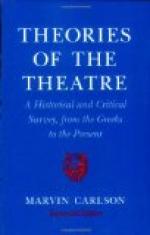No writer is really a dramatist unless he recognises this distinction of appeal; and if an author is not accustomed to writing for the crowd, he can hardly hope to make a satisfying play. Tennyson, the perfect poet; Browning, the master of the human mind; Stevenson, the teller of enchanting tales:—each of them failed when he tried to make a drama, because the conditions of his proper art had schooled him long in writing for the individual instead of for the crowd. A literary artist who writes for the individual may produce a great work of literature that is cast in the dramatic form; but the work will not be, in the practical sense, a play. Samson Agonistes, Faust, Pippa Passes, Peer Gynt, and the early dream-dramas of Maurice Maeterlinck, are something else than plays. They are not devised to be presented by actors on a stage before an audience. As a work of literature, A Blot in the ’Scutcheon is immeasurably greater than The Two Orphans; but as a play, it is immeasurably less. For even though, in this particular piece, Browning did try to write for the theatre (at the suggestion of Macready), he employed the same intricately intellectual method of character analysis that has made many of his poems the most solitude-compelling of modern literary works. Properly to appreciate his piece, you must be alone, just as you must be alone to read A Woman’s Last Word. It is not written for a crowd; The Two Orphans, less weighty in wisdom, is. The second is a play.
The mightiest masters of the drama—Sophocles, Shakespeare, and Moliere—have recognised the popular character of its appeal and written frankly for the multitude. The crowd, therefore, has exercised a potent influence upon the dramatist in every era of the theatre. One person the lyric poet has to please,—himself; to a single person only, or an unlimited succession of single persons, does the novelist address himself, and he may choose the sort of person he will write for; but the dramatist must always please the many. His themes, his thoughts, his emotions, are circumscribed by the limits of popular appreciation. He writes less freely than any other author; for he cannot pick his auditors. Mr. Henry James may, if he choose, write novels for the super-civilised; but a crowd is never super-civilised, and therefore characters like those of Mr. James could never be successfully presented in the theatre. Treasure Island is a book for boys, both young and old; but a modern theatre crowd is composed largely of women, and the theme of such a story could scarcely be successful on the stage.
In order, therefore, to understand the limitations of the drama as an art, and clearly to define its scope, it is necessary to inquire into the psychology of theatre audiences. This subject presents two phases to the student. First, a theatre audience exhibits certain psychological traits that are common to all crowds, of whatever kind,—a political convention, the spectators at a ball-game, or a church congregation, for example. Second, it exhibits certain other traits which distinguish it from other kinds of crowds. These, in turn, will be considered in the present chapter.




